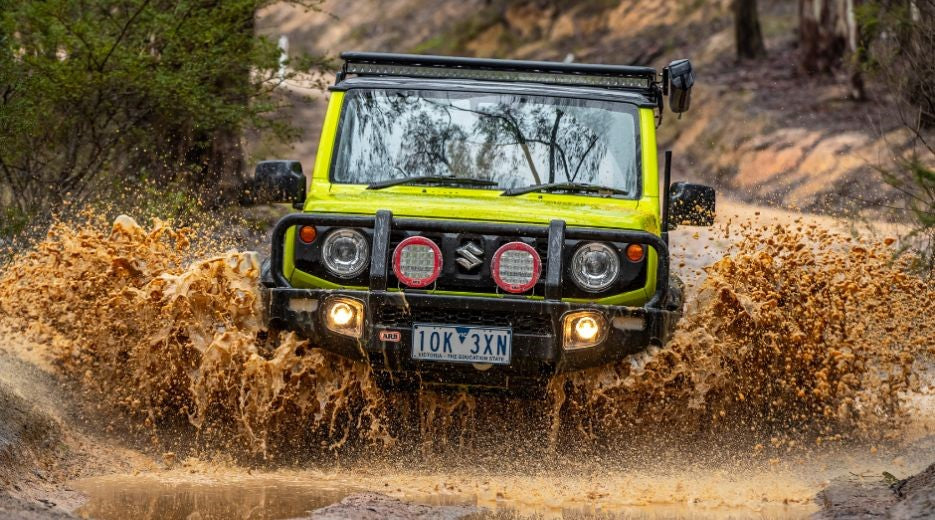Whether you're a seasoned pro or casual weekend warrior, coming across a water crossing while off-roading can be a real game-changer. Sure, that innocent-looking puddle might not be anything to worry about. Or it could be an ocean of trouble waiting to sink your ride -- and anyone inside it.
Like most things related to smart trail-riding, navigating a water crossing requires a little finesse. Nothing too crazy – just a level head, some thoughtful preparation, and basic skill. Think of it like a pop quiz, compliments of Mother Nature. And if you want to pass (literally and figuratively), you’ll need to do a little strategizing.
Know Your Ride

Before you even leave the garage, it’s important that you have a solid understanding of what your ride can and cannot handle. Size, ground clearance, and drivetrain all affect how your vehicle behaves when facing a water crossing. Understanding the limitations of each will help you choose the best approach and technique.
Even with high ground clearance and 4WD, a stock vehicle is no match for anything beyond very shallow bodies of water. So, if you think your off-road adventures might take you through more than the occasional babbling brook, it’s time to hit the aftermarket.
One of the simplest mods you can make to better tackle water crossings is to extend the differential breather tubes, moving them to a higher spot. This helps decrease the chance of water being sucked into the differential housing and causing serious damage.
Similarly, consider where your air intake is located – that height will determine what kind of water depth you can manage. If challenging terrain and deeper water crossings are something you’re interested in learning to master, then investing in a quality snorkel kit might make sense. Snorkels help keep the engine breathing by raising the air intake point above the vehicle's roof level. (Also, they look cool, which is probably why you see so many of them in the grocery store parking lot.)
Other helpful upgrades include a lift kit and larger tires, as well as a winch and comprehensive recovery kit for when things go wrong. Speaking of which, electronic components are the most likely to take a hit, even during mild interactions with water. So, be mindful of where the most critical bits are located, properly seal all wiring connections, and always carry some extra fuses.
And don’t forget to install the drain plugs if your vehicle comes with them!
Mind The Terrain

Do a little research before you hit the trail, especially if you’re headed into a new environment. Find out if water crossings are something you’re likely to encounter, and whether or not there are alternate routes.
Remember, just because the water is there doesn’t mean it must be crossed. Besides, the force of the current or condition of the weather may prevent you from doing so anyway. Which reminds us -- you should be checking those too.
When you do encounter a water crossing, don’t simply plow forward with more confidence than sense. Looks can be deceiving, so before you attempt to cross, you need to accurately assess the water's depth.
Scout it out, by exiting your vehicle and examining the water. Throw a rock or use a long object to gauge water depth. Better yet, get on in there and walk through. Hidden depths and obstacles, loose ground, fast flow – these can all seriously rough up your ride and put you and your passengers at risk. So, do some recon, and always err on the side of caution.
If you have to go around rather than through, think of it as simply an opportunity to spend more time on the trail.
Slow Your Roll

Once you’ve assessed the situation and determined the water crossing is both safe and necessary, pick your line and proceed slowly. You’re not racing rapids here; easy does it. Barreling into the water and making a big splash is a great way to hydrolock your vehicle – even in shallow water, so move with caution.
Once you’re in, keep it moving slow-and-steady at an even speed. Stopping or shifting (if you’re in a manual) can cause stalling. When you reach the other side of the crossing, pull the vehicle far enough ahead to prevent sliding or getting stuck in mud, and also so that any other rigs in your group can safely exit the water too.
After crossing, give your brakes a few gentle taps to dry them out and, once back on the trail, shift in and out of 4-wheel drive if you can to make sure all systems are working properly. When you're back home, inspect your differentials and transfer case for water or mud buildup.
Prepare for the Worst

As always, it’s important to expect the unexpected. Sometimes, no matter how careful you are, things go sideways – literally. If you start losing traction, stay calm and do not over-rev the engine; all that does is spin the wheels and throw water. Just ease off the accelerator and your wheels should regain traction.
If you stall out in deep water, and there’s a chance it has reached your air intake, do not attempt to start the engine. Doing so can lead to hydrolocking, which can result in extensive engine damage. Instead, get everyone out of the vehicle (safety first!) and determine what is the best move forward – securing the rig for recovery or calling in emergency help.
Off-road adventures can throw unexpected challenges your way, but that’s half the fun! Following these steps and keeping calm – even when things get slippery – will ensure you can glide through off-road water crossings like a pro.

